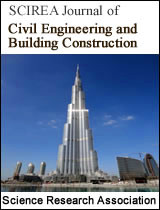Fundamental Study on Glass Fiber-Reinforced Geopolymer Mortar
DOI: 10.54647/cebc560118 88 Downloads 108501 Views
Author(s)
Abstract
Glass fiber-reinforced mortars (GRM) are widely used exterior material in construction. However, their flexural strength decreases owing to the deterioration of glass fibers in alkali environment, which can be attributed to the formation of Ca(OH)2. On the other hand, Geopolymers (GP) that do not use cement as a binder can hinder the formation of Ca(OH)2. Therefore, it is assumed that GRM as a GP mortar can suppress the deterioration of alkali-resistant glass fibers. In this study, we experimentally examine the compression and flexural strength of glass fiber-reinforced GP mortar. Our results show that the compression strength of the GP mortar decreased as the addition rate of the retarding admixture increased, regardless of the alkaline water or fly ash ratio. However, the fluidity enhanced with the addition of coagulation retardant with strength exceeding 1.0%. Furthermore, the glass fiber-reinforced GP mortar exhibited a relatively smaller flexural compared to glass fiber-reinforced mortars, using ordinary Portland or GRC cements. It was confirmed that there was no alkali-induced deterioration of the alkali-resistant glass fiber until 28 d of material age.
Keywords
Geopolymer, glass fiber, fly ash, citric acid anhydride, compression strength, flexural strength
Cite this paper
Chihiro Nagata, So Goto, Akihiro Maegawa, Takashi Hirose, Toshitsugu Inukai,
Fundamental Study on Glass Fiber-Reinforced Geopolymer Mortar
, SCIREA Journal of Civil Engineering and Building Construction .
Volume 8, Issue 1, February 2023 | PP. 49-64.
10.54647/cebc560118
References
| [ 1 ] | S. Akihama, T. Suenaga, H. Nakagawa, H. Fujii (1986). MECHANICAL PROPERTIES AND DURABILITY OF GLASS FIBER REINFORCED CEMENT USING GRC CEMENT, Proceedings of the 8th Japan Concrete Institute Conference, pp. 417-420 |
| [ 2 ] | S. Goto, T. Inukai, Y. Uehara, and T. Hirose (2018). EFFECT OF SODIUM METASILICATE ADDITION METHOD AND SET RETARDING MIXTURES ON THE COMPRESSION STRENGTH CHARACTERISTICS AND FLOW VALUE OF A GEOPOLYMER OVER TIME, Proceedings of the Japan Concrete Institute, Vol. 40, No. 1, pp. 1821-1826 |
| [ 3 ] | S. Goto, T. Inukai, A. Maegawa, T. Hirose (2019), EFFECT OF GEOPOLYMER MIXING METHOD AND SIMULATED DRY SLUDGE POWER MIXING RATE ON THE COMPRESSION STRENGTH: Proceedings of the Japan Concrete Institute, Vol. 41, No. 1, pp. 1943-1948 |
| [ 4 ] | J. Davidovits. (2011). Geopolymer Chemistry and Applications, Institute GEOPOLYMER |
| [ 5 ] | Dr. Mrs. S. A. Bhalchandr and Mrs. A. Y. Bhosle (2013). PROPERTIES OF GLASS FIBRE REINFORCED GEOPOLYMERCONCRETE, International Journal of Modern Engineering Research, Vol. 3, No. 4, pp. 2007-2010 |
| [ 6 ] | K. Korniejenko, J. Mikula and M. Lach (2015). CHARACTERIZATION OF MECHANICAL PROPERTIES OF SHORT GLASS FIBER-REINFORCED GEOPOLYMER COMPOSITES,10th International Conference on Composite Science and Technology |
| [ 7 ] | Japan GRC Industrial Association (1998). GRC Industrial Association Standard, pp. 1-8, 55-57 |
| [ 8 ] | D. Hardjito and B. V. Ranga (2005) DEVELOPMENT and PROPERTIES OF LOW-CALCIUM FLY ASH-BASED GEOPOLYMER CONCRETE, Research Report GC 1 Faculty of Engineering Curtin University of Technology, Perth, Australia |
| [ 9 ] | Japan GRC Industrial Association (1996). Physical Properties of GRC and Its Testing Methods, pp. 70-74 |
| [ 10 ] | Nippon Electric Glass Co., Ltd. (2000). Pre- Mixed GRC Technical Data (Basic Edition), pp. 2-4 |
| [ 11 ] | Kunihiro H., Hiroshi Y., Tadahiko S. and Takashi W. (1993). A STUDY ON HIGH FLUID PREMIXED GLASS-FIBER REINFORCED CONCRETE: Proceedings of the Japan Concrete Institute, Vol. 15, No. 1, pp. 963-968 |

